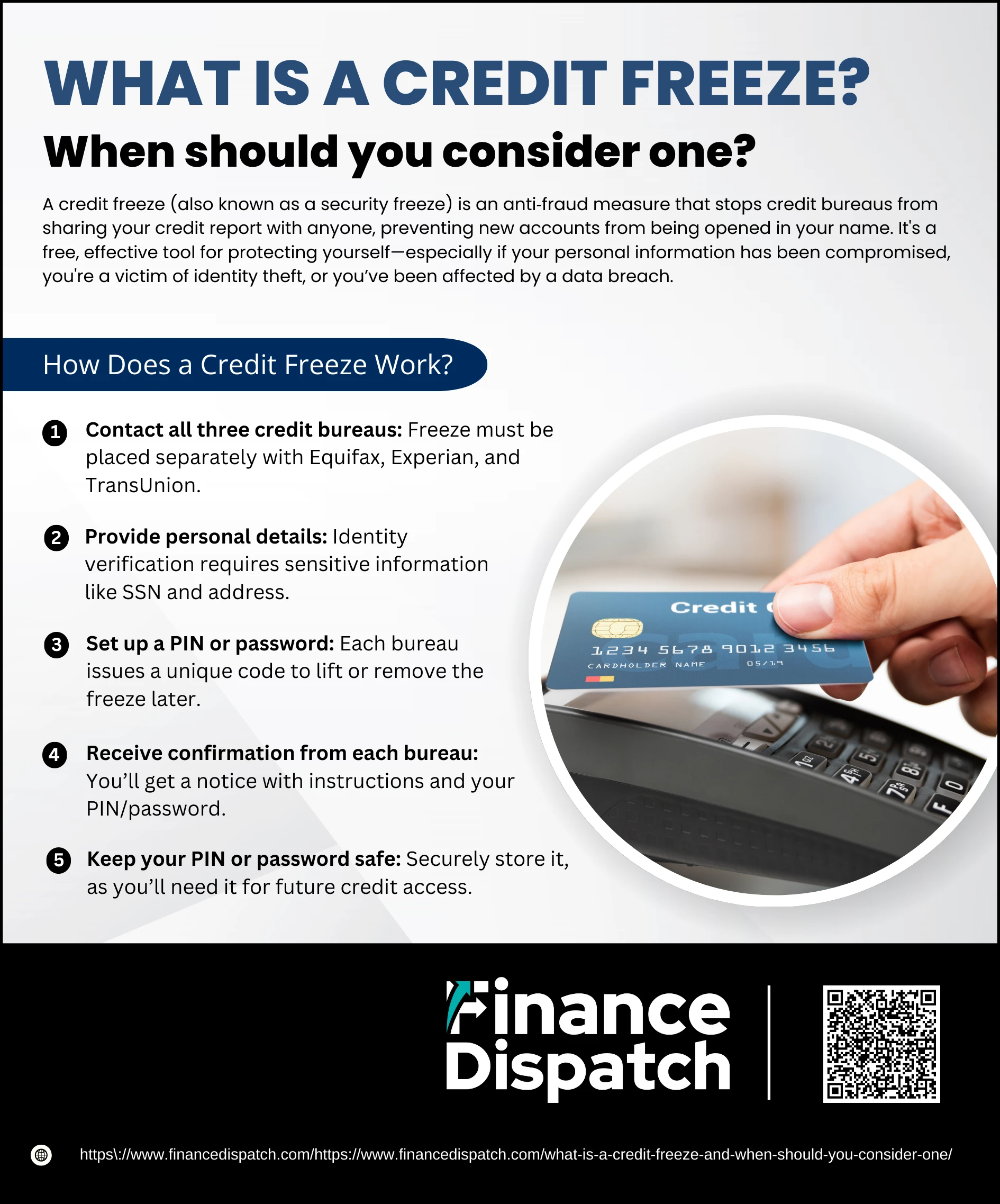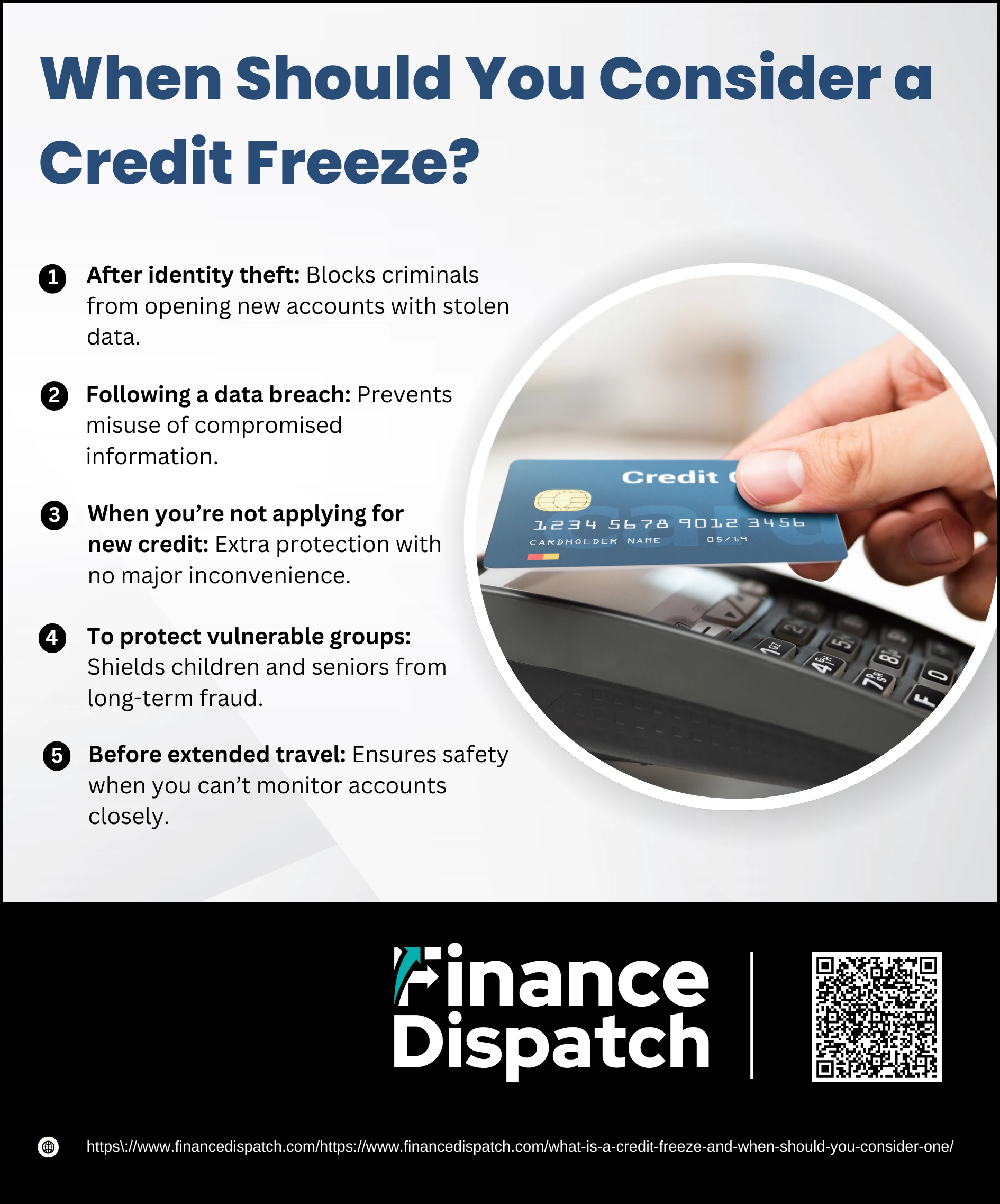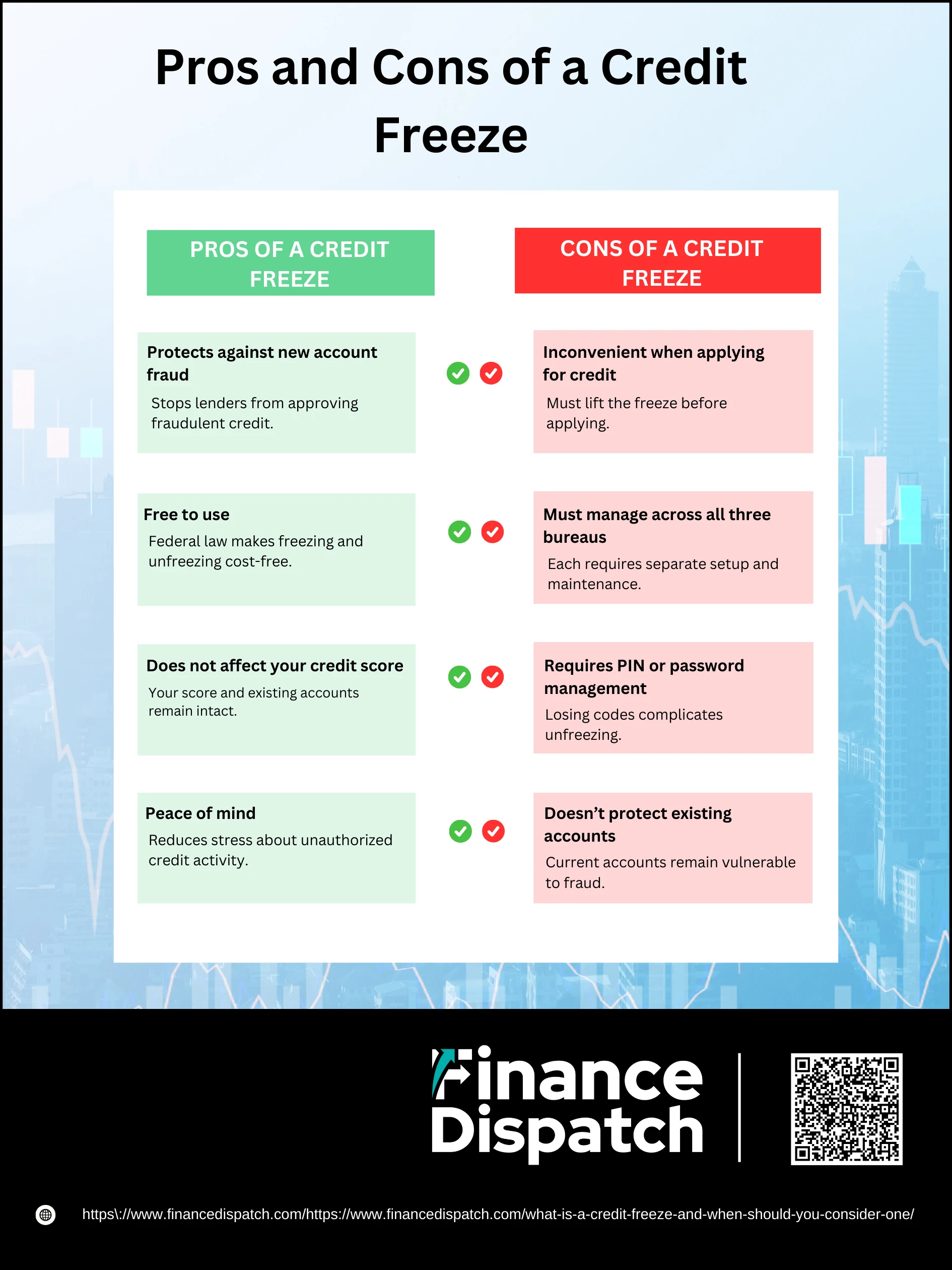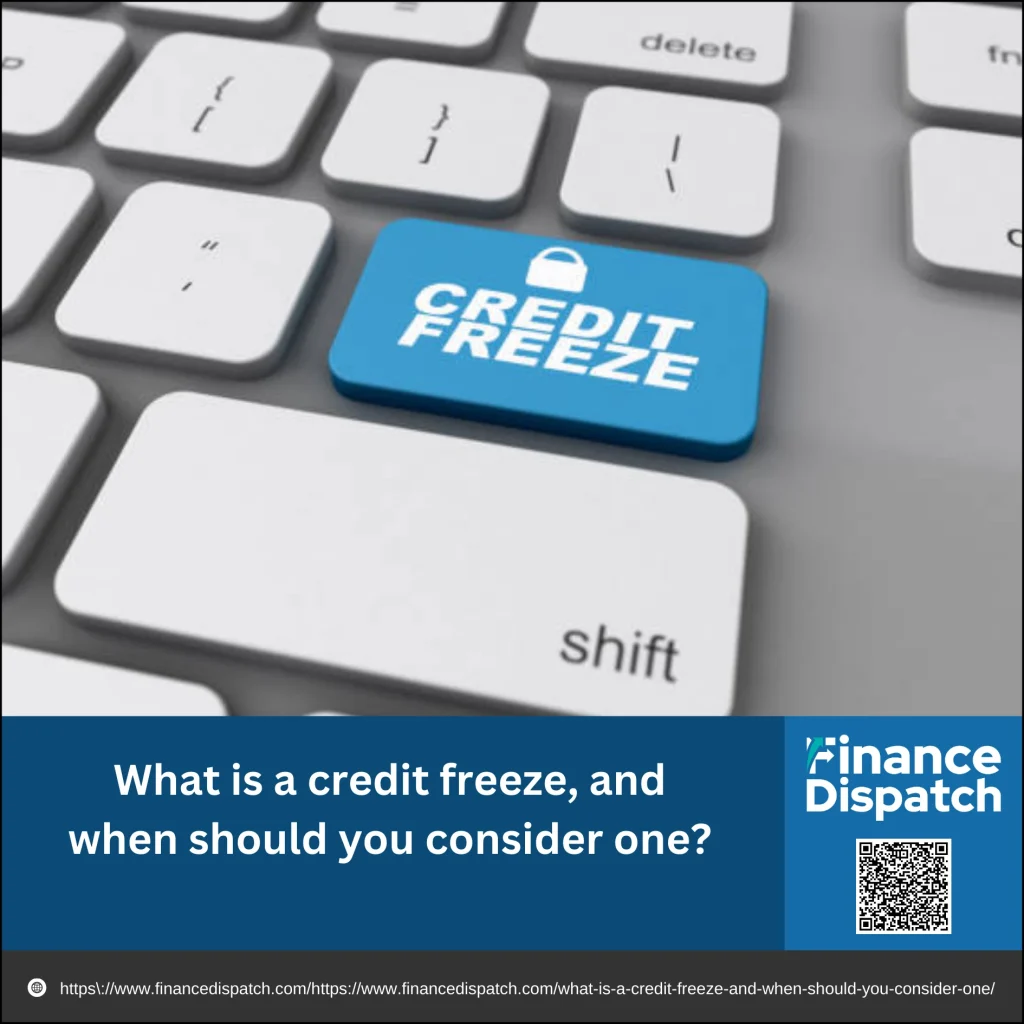In today’s digital world, protecting your personal and financial information has never been more important. With millions of Americans falling victim to fraud and identity theft each year, even a small data breach can put your credit and financial future at risk. One of the strongest tools available to safeguard yourself is a credit freeze, also known as a security freeze. This simple yet powerful step can stop criminals from opening new accounts in your name, giving you greater control over who can access your credit report. But while it offers valuable protection, a credit freeze isn’t always the right choice for every situation—which is why it’s important to understand how it works and when you should consider using it.
What is a Credit Freeze?
A credit freeze, sometimes called a security freeze, is a way to lock your credit report so that new lenders or creditors cannot access it without your permission. Since most financial institutions require a credit check before approving a loan, credit card, or other account, a freeze makes it much harder for identity thieves to open fraudulent accounts in your name. Importantly, freezing your credit does not affect your credit score, nor does it stop you from using your existing accounts. You can still view your own credit report and continue making normal payments on your credit cards, loans, or mortgages.
 How Does a Credit Freeze Work?
How Does a Credit Freeze Work?
A credit freeze limits who can see your credit report, making it much harder for fraudsters to open accounts in your name. To put one in place, you’ll need to work directly with all three major credit bureaus, since freezing with one does not automatically cover the others. Here’s how the process works:
Steps to place a credit freeze:
1. Contact all three credit bureaus
You must place a freeze with Equifax, Experian, and TransUnion separately. This can be done online through their official websites, by phone, or by mail. Freezing your credit with one bureau does not extend to the others, so it’s essential to complete the process with all three.
2. Provide personal details
To verify your identity, the bureaus will ask for sensitive information such as your full name, date of birth, Social Security number, current and past addresses, and sometimes scanned copies of identification documents. This step ensures only you can request the freeze.
3. Set up a PIN or password
Once your request is processed, each bureau will issue you a unique PIN or password. This code acts as your key to temporarily lift (“thaw”) or permanently remove the freeze whenever you need new credit. Keeping this information secure is critical to managing your freeze.
4. Receive confirmation from each bureau
After the freeze is placed, each bureau will send you confirmation by mail, email, or through your online account. This notification will include your PIN or password, along with instructions for lifting the freeze in the future.
5. Keep your PIN or password safe
Store your PIN or password in a secure place, such as a password manager or locked file. You’ll need this code any time you want to apply for credit, rent an apartment, or undergo a background check for employment that requires access to your credit file.
 When Should You Consider a Credit Freeze?
When Should You Consider a Credit Freeze?
A credit freeze is not something you need to activate at all times, but there are certain situations where it can be a smart move. Think of it as a protective shield you put up when your personal information is at higher risk. Below are the scenarios where freezing your credit is most beneficial:
1. After identity theft
If your Social Security number, bank details, or other personal data has been stolen, criminals may try to use it to open new credit cards or loans in your name. A credit freeze blocks these attempts by stopping lenders from accessing your report, giving you time to recover and secure your identity.
2. Following a data breach
Massive data breaches at retailers, financial institutions, and even credit bureaus themselves have exposed millions of people’s personal information. If you’ve been notified that your data was compromised, placing a freeze immediately limits the chances of that stolen information being misused for credit fraud.
3. When you’re not applying for new credit
If you don’t plan on applying for a mortgage, auto loan, or new credit card anytime soon, there’s little downside to freezing your credit. Since you won’t need frequent access to your credit file, the extra protection comes at no cost and with minimal disruption to your daily life.
4. To protect vulnerable groups
Children and elderly individuals are frequent targets of identity theft. Children’s Social Security numbers can be especially valuable because fraud can go undetected for years until they apply for credit as adults. Similarly, seniors are often targeted for scams. Freezing their credit helps prevent long-term harm.
5. Before extended travel
If you’ll be out of the country or unable to monitor your accounts closely for weeks or months, freezing your credit can give you peace of mind. This way, even if someone tries to misuse your identity while you’re away, they won’t be able to open new accounts in your name.
 Pros and Cons of a Credit Freeze
Pros and Cons of a Credit Freeze
A credit freeze is often seen as one of the best defenses against identity theft, but it’s not without some trade-offs. To make an informed decision, it helps to look closely at both the advantages and disadvantages.
Pros of a Credit Freeze
1. Protects against new account fraud
When your credit is frozen, lenders and creditors can’t access your report to verify new credit applications. Since most financial institutions require this step, fraudsters attempting to open accounts in your name will likely be denied. This makes a freeze one of the strongest tools against new account fraud.
2. Free to use
In the past, some states charged fees for placing or lifting a freeze, but since 2018, federal law requires that credit freezes be free nationwide. You can place, lift, or remove a freeze as many times as needed without paying anything, which makes it a cost-effective option for long-term security.
3. Does not affect your credit score
Freezing your credit does not lower your credit score or prevent you from using your existing accounts. You can still pay bills, manage your credit cards, and request your free annual credit reports. This means you gain protection without sacrificing your financial standing.
4. Peace of mind
Identity theft can be stressful, costly, and time-consuming to fix. A freeze can give you confidence that your credit file is locked down against unauthorized access, reducing anxiety about someone opening new accounts in your name.
Cons of a Credit Freeze
1. Inconvenient when applying for credit
If you’re shopping for a new mortgage, auto loan, or even a utility service that requires a credit check, you’ll have to temporarily lift the freeze. This adds extra steps to the process and may cause delays if you don’t plan ahead.
2. Must manage across all three bureaus
Freezing your credit at one bureau isn’t enough—you need to contact Equifax, Experian, and TransUnion separately. Each has its own system, which means more time and effort to set up and maintain the freeze.
3. Requires PIN or password management
Each bureau issues a unique PIN or password to manage your freeze. If you lose or forget these credentials, it can complicate or delay the process of lifting the freeze when you need access quickly.
4. Doesn’t protect existing accounts
A freeze only blocks new accounts from being opened—it doesn’t stop criminals from using information tied to your current accounts. For example, if someone steals your credit card number, they can still make unauthorized purchases. Regular monitoring of your bank and credit card statements is still essential.
How to Lift or Thaw a Credit Freeze
There may come a time when you need to apply for new credit, rent an apartment, or undergo a background check for employment. In these cases, you’ll have to temporarily lift—or permanently remove—your credit freeze. The process is straightforward, but it must be done through each credit bureau individually.
Ways to lift or thaw your credit freeze:
1. Temporary lift for a specific time period – You can unfreeze your credit for a set number of days, which is useful if you’re shopping for a loan or credit card. After the time ends, the freeze will automatically go back into effect.
2. Temporary lift for a specific creditor – If you know which company will run your credit check, you can allow access for just that creditor, keeping your file protected from others.
3. Permanent removal – If you no longer want your credit frozen, you can request a full removal with all three bureaus. This completely restores access to your credit file.
4. Timing matters – Online or phone requests are often processed within an hour, while mail requests may take up to three business days.
5. Keep your PIN or password handy – Each bureau requires the unique code you received when placing the freeze. Without it, lifting the freeze may be delayed.
Credit Freeze vs. Alternatives
While a credit freeze is one of the strongest protections against identity theft, it’s not the only option available. Other tools like fraud alerts and credit locks also help secure your financial information, but each works differently and has its own advantages. Comparing these options side by side makes it easier to decide which is best for your situation.
Comparison Table:
| Tool | What It Does | Best Use Case | Cost | Legal Protection |
| Credit Freeze | Restricts access to your credit report; blocks new accounts without your consent | Strong protection after identity theft or major data breach | Free (by law) | Backed by federal law |
| Fraud Alert | Requires lenders to verify identity before issuing new credit | If you suspect, but haven’t confirmed, identity theft | Free | Protected by federal law |
| Credit Lock | Lets you lock/unlock your credit instantly via app or online portal | Convenient for frequent use, but not as strong as a freeze | May be part of paid plan | Not legally binding |
Conclusion
A credit freeze is one of the most effective steps you can take to guard against identity theft and unauthorized credit activity. By locking down your credit report, you gain control over who can access it, making it much harder for fraudsters to open new accounts in your name. While it does require some effort to manage—especially when you need to apply for credit—the protection it offers often outweighs the inconvenience. Whether you choose a credit freeze, fraud alert, or credit lock, the key is to stay proactive about monitoring your financial information. Combining these tools with regular credit checks and account monitoring will give you greater peace of mind and a stronger defense against fraud.



